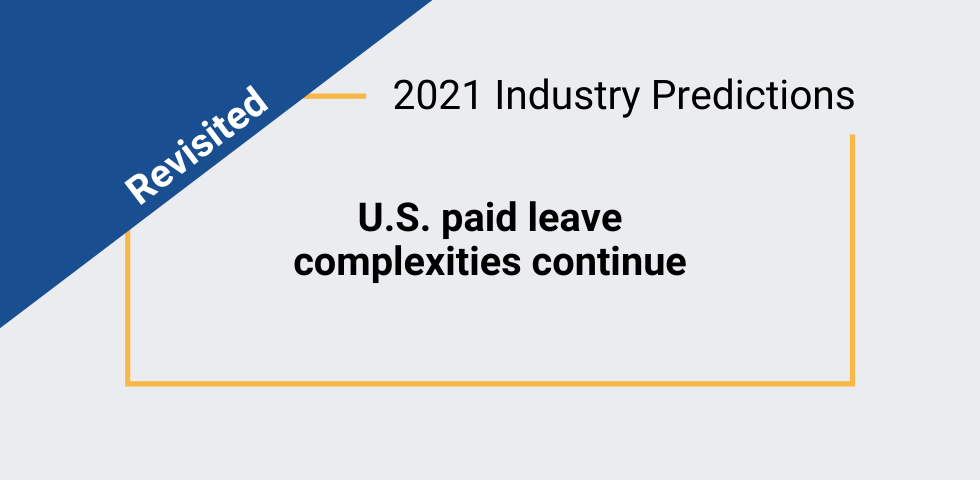In a season that has been full of change, 2021 has also put a spotlight on Paid Family and Medical Leave (PFML). At the beginning of the year, we shared details about PFMLs that made their debut in Maine and Massachusetts. But that was far from the end of the story. As we conclude our reflections series on earlier industry predictions, we’re looking at where the United States went with leave acts throughout the year.
There was a lot of activity across multiple states, including a proposal within the most recent legislation pending before the U.S. Congress. While that provision has been added, removed, and added back again, the fate of a national paid leave plan remains in limbo until the final negotiations are made between chambers of the House and Senate, and are ultimately passed into law.
In the meantime, here are some highlights of what has occurred so far this year regarding Paid Family (PFL) and Medical Leave (PML):
-
- Four additional PFL or PML plans have been passed into law in Connecticut, Oregon, New Hampshire, and Colorado. In each of these states, legislation has passed and implementation is pending. Three additional states (Illinois, Maryland, and Pennsylvania) have legislation that is still pending, and the final outcome in these states remains unclear.
- While 13 states had no activity around paid leave programs in 2021, 22 other states had bills that ultimately failed during this year’s legislative sessions.
As always, numerous differences exist across various states regarding what is included in a new PML/PFL program. Here are some highlights from each of the four states where plans are approved and pending implementation:
-
- In Connecticut, benefits are scheduled to begin on January 1, 2022. As an eligibility requirement, employees must have worked in the state for the last 12 weeks. Benefits are payable for a maximum of 12 weeks for combined family or self-leave. Certain pre-pregnancy complications may entitle the employee to an additional two weeks of benefits. The plan is employee funded under a 0.5% payroll deduction. The max benefit is up to 60 times the state minimum wage, to a maximum of $780. One unique thing about the Connecticut plan is that there is no “job protection,” outside of what an employee would receive under FMLA. Connecticut has approved both self-funded and insured plans, and any benefits paid under the program are offsetable under a traditional STD plan
-
- New Hampshire’s plan is a bit unique in several respects. Before the plan goes into effect in 2023, the state will issue an RFP to carriers to either insure or administer the state plan. The plan must cover New Hampshire state employees and must establish a purchasing pool to cover other employers who have at least 50 employees. The plan will allow employers to choose whether they pay all, part, or none of the premiums. Benefit calculations are straightforward, providing 6 weeks of leave with a simple calculation of 60% up to the FICA tax cap level. One other unique provision of the plan provides for self and family paid coverage for non-state government employees, while the plan provides for family-only paid benefits for state government employees.
-
- Oregon is still in the process of program design, which has been delayed for some time. The state is using an approach very similar to the one which Washington used. Washington used a phased approach, which caused a good deal of confusion during implementation and roll out of the plan. Hopefully this approach will work better in Oregon.
-
- Finally in Colorado, contributions to the state plan will begin on January 1, 2023. Benefit payments may begin on January 1, 2024. The plan is being funded by a 0.9% payroll deduction with a funding split of 50% employer paid/50% employee paid. Employers may choose to self-fund their plans, but the state still hasn’t decided whether insurance under a private plan will be an option. The wording of the plan allows for insured plans; however, the state department of insurance has indicated that they aren’t clear on whether they have the jurisdiction to establish the rules around such plans. Sounds like there’s more clarity to come on the Colorado plan.
It will be important to see what happens with federal legislation around a Paid Family and Medical Leave program, as it relates to predicting the future of this coverage. The basics of the plan that have been shared to date haven’t been nearly as rich as most of the state plans that exist today. Given this, the thinking that a federal program would solve for the issue doesn’t appear to be materializing.
The patchwork of unique state plan provisions can be a headache in terms of plan administration for both employers, administrators, and insurers alike. Until a federal plan that addresses these issues is approved, it looks like the industry will have to continue delivering solutions for employers to navigate an ever changing and complex leave landscape.




